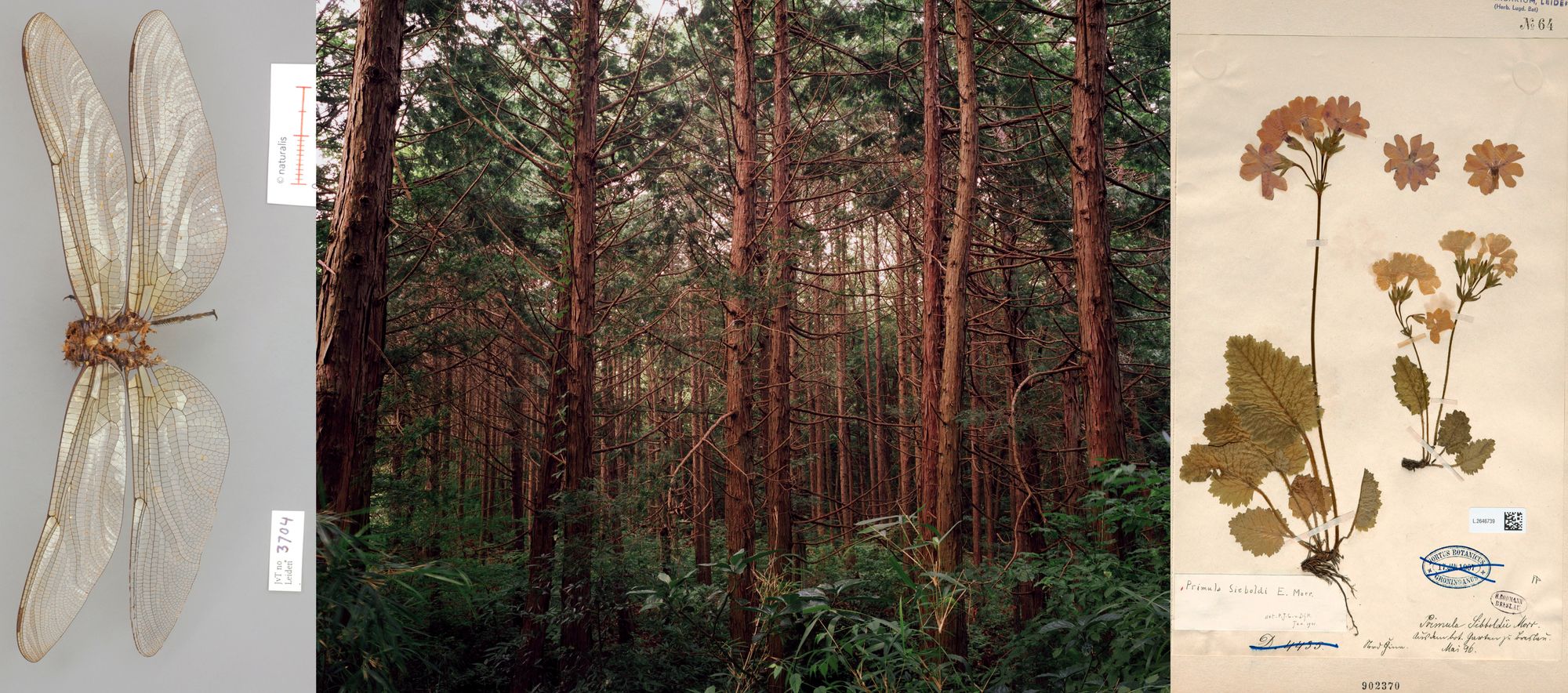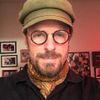014
"Fukushima is a radical break from centuries of the cultural understandings of nature, landscapes and mankind’s relation to them."

ARTIST FEATURE
new approaches to climate
Robert Knoth and Antoinette de Jong - Tree and Soil

From Hartmann Books:
Following the 2011 nuclear disaster Robert Knoth and Antoinette de Jong photographed and filmed the changing landscapes in the closed zones around Fukushima over a period of five years. They documented evacuated farmhouses, gardens, agricultural fields, and the surrounding hills and forests and interviewed former inhabitants of the area. In this book they combine their own landscape photography with historical material from the collection of naturalist and explorer Philipp Franz von Siebold. Siebold’s collections [...] illustrate how Japanese culture is deeply rooted in and inspired by nature. In Tree and Soil Knoth and de Jong underline the intrinsic beauty and value of nature, connecting the past and present by documenting and interpreting the transformations of the deserted landscapes around Fukushima.
"At times we felt like archaeologists of the future, trying to understand what happened in a distant past when a mysterious force resulted in the evacuation of towns, villages, and forests, leaving only a residue of human presence."

Viaduct Arts interview with Robert Knoth
What was your goal in juxtaposing your photographs with the historical material from Siebold's collection? How did that idea evolve?
The idea evolved quite naturally. We felt that the original work we made wasn't enough for what we wanted to express. During our research period, we ran into Siebold’s collection of dried plants, cultural artifacts, the specimens of animals and insects. We felt very much there was a connection between his collection and our work and started combining the two.
Early 19th-century Phillip Franz von Siebold lived in the Dutch trading post Deshima as a physician on behalf of the Dutch Government. His historical collection perfectly illustrates the ambiguity of humans towards nature. On the one hand, nature is a source of materials ready to be exploited. At the same time, his collection shows that culture, religion, technology, everyday life have deep roots within nature, it is the foundation of any civilization. Therefore nature has to be cherished and nurtured and celebrated.

How did you protect yourselves from radiation when working in contaminated areas around Fukushima?
We had a dosimeter, which signaled us when radiation got too high. One tries to avoid dust, mud or touching objects which might be contaminated. In practical terms, it was hard to pay attention to it all the time. We were there only for short periods, which reduces the risks.
How do you see the Japanese cultural relationship with nature, how much of that is romanticized or even contradictory? I mean there are Miyazaki and Kurosawa's dream-like visions, traditional Shinto notions of spirits in everything, and modern traumas from Hiroshima to Fukushima. How does one reconcile all of that, and does your work attempt to do so?
Our works attempt to show that Fukushima is a radical break from centuries of the cultural understandings of nature, landscapes and mankind’s relation to them. A relation that has always been ambiguous, as said earlier. But Japanese nature was first and foremost understood as place before the Industrial Revolution. The nuclear disaster was the outcome of a process where mankind overplayed its hand, destroying the very thing it cherished most: home as a place of one's identity, as a place of being.
That is also where Siebold comes in on another level, as one of many scientists at the beginning of the Industrial Revolution starting to collect, categorize, and tame nature and her secrets for the benefit of mankind. Fukushima is a clear example of how this development has reached an inflection point, where mankind itself poses the greatest danger rather than the natural world.

Your book Certificate no. 000358/ also addresses the nuclear question, in the context of the Soviet-era nuclear legacy. You and I worked together on the 2006 Chernobyl20 exhibition project, which highlighted the human cost when nuclear goes wrong. In the climate crisis, some still argue that nuclear has a role to play. What is your response? How do we get to where we need to be in terms of the world's energy needs?
Certificate no.000358/ is about nuclear power at first glance, but on a secondary level it is a book about power, a book about governments and all of its state institutions, doctors, scientists, military as well as political leaders willing to sacrifice large numbers of people it is supposed to protect for political ideals. Nuclear technology as a tool for political power, as a tool to suppress and oppress.
There is a line from that point of view to the flawed debate about nuclear power concerning climate change. No technology is going to save us from ourselves, or from our current destructive trajectory.
Our behavior as human beings lies at the core of all of our contemporary issues. That is where the real solution has to come from. Not technology.
To quote Robert McNamara in the brilliant documentary The Fog of War: "You cannot change human nature, at least not anytime soon". I re-watched the documentary shortly after the Russian invasion of Ukraine for obvious reasons - the renewed threat of nuclear war.
Russia, by the way, controls about 35% of the worldwide market of nuclear fuel production, storage and re-processing, doing business with over 20 European and Asian countries and the United States. The country is very ambitious about expanding their already indispensable role in the global nuclear industry. So, yeah, let’s go and knock ourselves out on nuclear.
FUTURE-MUSIC
music to carry us forward

Short UK run of shows you don't want to miss if that's where you find yourself in early summer. Gwenifer Raymond and Viaduct alum Yasmin Williams are two of the most formidable and innovative artists out there at the moment, utterly reinventing the notion of 'guitar hero' in their own ways. Both are purely instrumental. GR takes indie-folk/American Primitive through a punk grinder and drops it down a dank Welsh coal shaft. YW applies her strong sense of melody and percussiveness to create a uniquely atmospheric, flowing sonic landscape. They are plenty virtuosic but tactile and even raw, valuing expression and personal vision over perfection, never letting you forget this is music forged by human hands.
Gwenifer Raymond: Strange Lights Over Garth Mountain review – eerily tangled roots music
The Guardian | November 6, 2020
Raymond’s accomplished guitar playing, inspired on her second album by her Welsh upbringing, makes for horror-tinged blues full of atmosphere
The Face of Solo Guitar Is Changing. It’s About Time.
New York Times | April 28, 2021
Since the heyday of John Fahey, the genre has been seen as the province of white men. A new generation of diverse players is rapidly changing that.
ROUNDUP
The Sound of Moomins – on turning the Moomin magic into music
Moomin.com | April 5, 2022
What does Moominvalley sound like? How do you interpret a universe already complete, like Tove Jansson’s Moomin stories, into music?
Composer and bass player Lauri Porra [great-grandson of Finnish composer Jean Sibelius] is currently making music for the Moomin brand. He describes his journey into interpreting Moomin into music as some kind of detective work.
“Tove Jansson was an artist that created a universe. The purpose of the music has been to support the world created by Tove Jansson. We have a lot of information, illustrations, text and thoughts and from there we try to find something that honours and fits that world. It's important to concentrate on Tove Jansson's vision and try to make music according to it without disturbing that clear core of her world.”
from Nostalgia for Cinema:

“One doesn't need to explain in film, but rather to directly affect the feelings of the audience. It is this awakened emotion that then drives the thoughts forward.”
Andrei Tarkovsky
IPCC report: ‘now or never’ if world is to stave off climate disaster
The Guardian | April 4, 2022
The world can still hope to stave off the worst ravages of climate breakdown but only through a “now or never” dash to a low-carbon economy and society, scientists have said in what is in effect a final warning for governments on the climate.
Greenhouse gas emissions must peak by 2025, and can be nearly halved this decade, according to the Intergovernmental Panel on Climate Change (IPCC), to give the world a chance of limiting future heating to 1.5C above pre-industrial levels.
It’s over for fossil fuels: IPCC spells out what’s needed to avert climate disaster
The final cost of doing so will be minimal, amounting to just a few percent of global GDP by mid-century, though it will require a massive effort by governments, businesses and individuals.
ACTION
Impact: Artists in Support of Refugees from Ukraine
Artsy & the Ukrainian Institute of Modern Art present Impact: Artists in Support of Refugees from Ukraine, an emergency benefit auction to support relief for refugees fleeing Ukraine. Artsy is donating a portion of the Buyer’s Premium to USA for UNHCR, which provides aid to people affected by the war in Ukraine and gives support to displaced families.
Featuring generous submissions from Ukrainian and non-Ukrainian artists alike, this auction highlights the impact and talent of contemporary Ukrainian artists. The representation of Ukrainian artists in this sale raises cultural awareness and stands as artistic preservation by placing artworks in the hands of protected collectors and funding Ukrainian artists to keep creating - an act that is now about survival and political defiance.
Bidding in the auction is open exclusively on Artsy and will close on Thursday, April 14th, 2022 at 12:00pm EDT.
